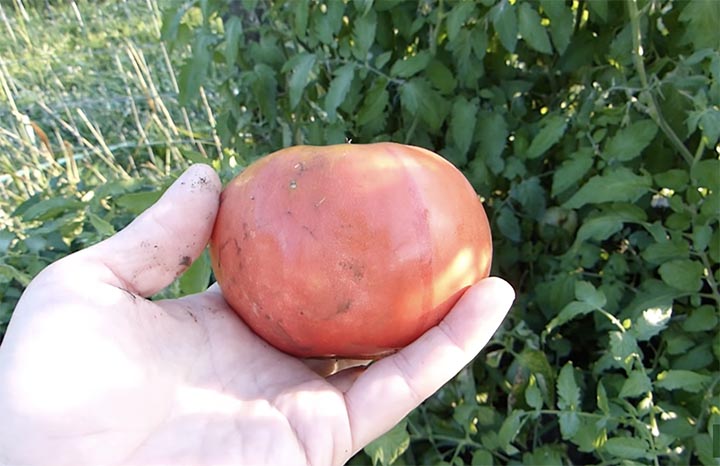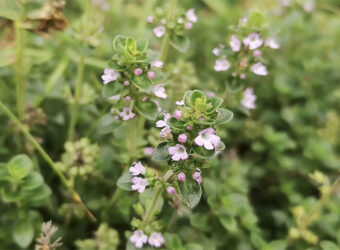When you realize that tomatoes include much more than mealy red slices slopped on sandwiches or bland cherry tomatoes tossed into salads, the world becomes a lot more exciting. But then you realize there are hundreds of different tomato varieties to choose from…and you only have so much room in your garden.
If you’re looking for a tomato that is the perfect size for slicing on sandwiches and tickles your taste buds with a sweet and acidic flavor, then check out the German Johnson.
This heirloom variety is known for its large and delicious fruits as well as a productive growth habit. I’ve grown it for multiple years and find it a worthy addition to both the garden and kitchen.
Keep reading to learn more about this variety as well as growing and harvest tips.
German Johnson Tomato – Quick Growing Guide
| Plant Type: | Annual vegetable | Tolerance: | Fruit cracking, heat |
| USDA Hardiness Zone: | 4–9 | Maintenance: | Moderate to high |
| Season: | Summer and early fall | Soil Type: | Rich and well-aerated |
| Exposure: | Full sun | Soil pH: | 6.2 to 6.8 |
| Time to Maturity: | 70–80 days after transplant | Soil Drainage: | Well-draining |
| Spacing: | 24 inches | Companion Planting: | Lettuce, basil, beets |
| Planting Depth: | 1/4 inch | Avoid Planting With: | Potatoes, peas, pole beans, corn |
| Height: | 6–8 feet | Family: | Solanaceae |
| Spread: | 2–4 feet | Genus: | Solanum |
| Water Needs: | Moderate | Species: | lycopersicum |
| Common Pests and Diseases: | Aphids, thrips, late blight, early blight, septoria leaf spot, anthracnose | Cultivar: | German Johnson |
The History of German Johnson Tomatoes
The German Johnson is an heirloom tomato variety that has been around for years. Its exact origins are unknown, but it is similar to the popular Brandywine heirloom tomato.
Its name doesn’t refer to European origins, but rather the likelihood that it was developed by Mennonite farmers in the Eastern United States.
While it’s unknown exactly when this variety was developed, we do know that it was around in the 1930s. That’s because it was one of four tomato varieties used to develop the famed Mortgage Lifter cultivar.
All About German Johnson Tomatoes
Okay, so let’s get the basics out of the way.
Heirloom or Hybrid?
German Johnson tomatoes are heirloom plants.
That means they’re open-pollinated, and that means they produce seeds that will grow into plants that are identical to their parents. Therefore, you can save seeds from ripe fruits and use them to grow new German Johnson plants the next year.
Heirloom plants also make it possible to play around with cross-pollination and the development of new tomato varieties. If you add pollen from a different heirloom tomato plant to a German Johnson flower, you will produce a tomato that has characteristics of the two varieties.
Determinate or Indeterminate?
German Johnson plants have an indeterminate growth habit. That means they will continue to grow as long as the weather remains warm and they have the sun, water, and nutrients they need to support themselves.
The plants will typically reach at least six feet tall, but it’s not unheard of for the vines to reach ten feet. This impressive growth means that it’s best to have a solid plan for trellising, staking, or otherwise containing your plants.
Their indeterminate form also means that the plants continue to produce new flowers and fruits over the course of the season. You can expect to harvest a few tomatoes from each healthy plant over the course of about three months.
You can read my article here to know the difference between determinate vs indeterminate tomato plants.
Fruit Size, Taste, and Texture
While knowing how a tomato plant grows is an important part of plant selection and gardening, most people care about the tomato fruits. And I get this!
So, what’s the deal with the German Johnson tomato?
First off, it’s beautiful. The fruits typically weigh around a pound and have a slightly-flattened round shape. The skin is bright pink with a slight orange tinge.
While many larger heirlooms are prone to cracked or bruised tops, the German Johnson typically remains smooth and aesthetically appealing.
When you slice into the fruits you’ll be met with smooth flesh that’s juicy yet firm. This is the type of tomato that adds a refreshing bite to sandwiches without causing the bread to turn to soggy mush—and that’s a win in my book.
And then there’s the taste!
The tomatoes are pleasantly acidic with a hint of sweetness. If you like your tomatoes on the tart side, this variety is a good option for you.
Another thing I really like about German Johnson tomatoes is their lack of seeds. This makes them a good option for canning and also just means they’re desirable to eat.
How to Plant German Johnson Tomatoes
I’ve written an article about growing heirloom tomatoes that you might want to check out.
If you’d like to try your hand at growing German Johnson tomatoes this year, keep these tricks and tips in mind.
Start with Healthy Plants
If you want to end up with robust and thriving plants, you’ll need to start with healthy seedlings! This remains true whether you start your own plants from seed or purchase seedlings from a garden center or nursery.
Since German Johnson is a relatively common tomato variety, you may be able to find seedlings for sale. When you’re selecting seedlings, look for plants with thick stems, green foliage, and an overall healthy form.
I like to select plants without fruits or flowers. However, if you can only find plants that are flowering, simply pinch the flowers off before planting.
If you’re growing your plants from seed, you should strive to produce a healthy seedling. Some of the biggest mistakes I see when people grow tomatoes from seed are a lack of light, overwatering, and cold air temperatures.
Here are a few tips for growing healthy seedlings:
- Tomato seeds germinate best between 70-85ºF; use a heated seedling mat if necessary.
- Use a rich and well-draining soil mix—this and this are two good options.
- Keep the soil moist but not wet.
- If you are using grow lights, position them just a few inches above the tops of the plants.
- Start your seeds at the proper time, about two months before you plan to transplant the seedlings outside.
Choose a Suitable Location
Even the healthiest transplants will not thrive if they’re planted in the wrong environment.
Tomato plants like plenty of light—while six hours of direct sun a day may be fine, they prefer ten hours.
You should also plant them in an area with well-draining soil. This means avoiding swampy or low-lying areas.
If you find that the soil is compacted, loosen it with a digging fork prior to planting. You can also add a few handfuls of aged compost to increase both aeration and drainage.
Test Your Soil and Amend as Necessary
While you can apply fertilizer after you plant your tomatoes, it’s helpful to start off with soil that contains well-balanced minerals.
I like to take a soil test each fall and then amend the soil as required. There are many soil testing labs that can provide accurate readings and helpful recommendations. If you’re not sure which lab to use, check with your local agriculture extension office for help.
Once you receive your test results, apply fertilizer and any necessary lime or sulfur in the fall. Applying these materials ahead of time will help them become available to next year’s plants.
One important caveat is to avoid applying nitrogen fertilizers ahead of time. These materials can easily leach out of the soil over the winter which can lead to lost money as well as environmental problems.
Plant at the Right Time
German Johnson tomatoes, like all tomatoes, do not take well to cold. Freezing temperatures will kill them and cold temperatures will stress the plants.
At the bare minimum, you should wait until the danger of frost has passed before planting your seedlings outdoors. Waiting until nighttime temperatures are consistently 50ºF or above will help the plants get off to a good start.
If you’re not sure of the weather in your area, you can look up your town’s average last frost date and use this as a guide.
Use Suitable Spacing
When it comes to time to actually plant your German Johnson plants, keep the plant’s height and sprawl in mind.
You should space individual German Johnson plants at least two feet apart. While you can tuck smaller plants like carrots, beets, and lettuce about a foot away from your tomato plants, avoid growing tall plants like pole beans and peppers next to your tomatoes.
Caring for German Johnson Tomatoes
Once your tomato plants are in the ground, don’t think your work is done! You’re just at the beginning of your tomato journey.
Providing the proper care through your tomato plant’s various life stages will help create healthy plants and heavy yields.
Trellising
As I mentioned above, German Johnson plants can get tall. Like, over your head tall.
Unless you want your tomato plants sprawling across your garden and taking out other plants, you support your plants in some ways. Staking and trellising are two common options.
If you want to keep things simple, you can place a basic metal tomato cage around your plant when it is still small.
You should note that German Johnson plants will likely outgrow the top of the cage, but this isn’t a huge deal. The foliage can become densely tucked in the cage, making it difficult to harvest the tomatoes.
Another trellising option is to place two tall stakes on either side of the tomato plant, about a foot or two away from the plant’s stem.
As the plant grows, you can tie pieces of twine between the two stakes, caging the tomato in between the two lines of twine. This method is often known as the Florida stake and weave.
Pruning
While you don’t need to prune your German Johnson plants, I find completing at least basic pruning is helpful in both preventing disease and keeping the plants under control.
When you prune, it’s always important to use sharp and clean tools. This will help spread diseases between plants and also create clean cuts that heal quickly.
I like to start pruning when the plants are between one and two feet tall. At this point, I remove any of the lower leaves that are touching the ground.
I then prune off the suckers, or the shoots that emerge between the plant’s main stem and the leaves. While this step isn’t necessary, it helps limit the plant’s size and make it more manageable.
As the plant grows above three feet, I stop removing the suckers. However, if time allows, I prune off excess leaves to increase airflow.
It’s important to remember there isn’t one right way to prune, and your plants will produce tomatoes even if you don’t prune them.
Watering
Like most tomato plants, German Johnson plants require a moderate amount of water. When you water, try your best to water the ground and avoid splashing the plant’s leaves.
The amount you’ll need to water will depend on rainfall, temperature, humidity, and other factors. With that said, you can expect to water your plants one to three times a week.
If possible, it’s best to provide multiple smaller waterings rather than one big watering. This will help keep the soil moisture level more consistent, which can help with the movement of nutrients and prevent fruit cracking.
Fertilizing
Tomato plants require a lot of nutrients, so fertilizing is a key part to keeping them healthy. However, it’s important that you use an appropriate fertilizer.
Since you’re after the plant’s fruits, you should choose a product that is higher in potassium and phosphorus than it is in nitrogen. It’s also good if the fertilizer contains some secondary and micronutrients like magnesium and calcium.
Fortunately, there are fertilizers that are designed specifically for tomatoes! Some products that work well include Espoma Organics Tomato-Tone and Neptune’s Harvest Tomato & Veg Fertilizer.
Pests and Diseases
If you have problems with pests and diseases, you can find the information in our guides below:
Harvesting
German Johnson plants will begin to produce ripe fruits about 70–80 days after you transplant them.
Fruits will start out small and green and eventually grow bigger. Once they reach their final size, they will begin to turn pink.
Tomatoes near the bottom of the plant will ripen before the ones near the top.
You can harvest the tomatoes as soon as they begin changing color, or wait until they are fully ripe. If you harvest unripe tomatoes, place them in a cool location (50-70ºF) to ripen.
Fully ripe fruits will store for a handful of days, so plan your harvests accordingly.
You can harvest as often as you like, but I find you’ll need to harvest at least twice a week to prevent tomatoes from becoming overripe.
Where to Buy German Johnson Seeds
Now that you know how to grow German Johnson tomatoes, it’s time to get started! Some places you can purchase seeds include Johnny’s Selected Seeds, Southern Exposure Seed Exchange, and Tomato Fest.






